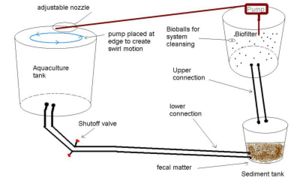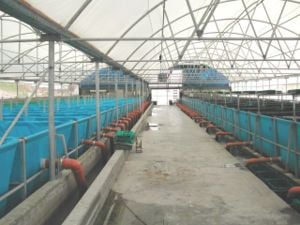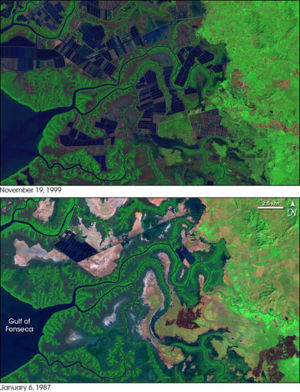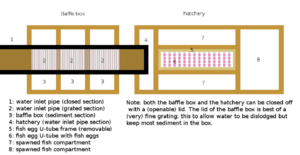



Aquaculture, or aquafarming, is the farming of aquatic organisms such as fish, crustaceans, molluscs and aquatic plants.[1][2] Aquaculture involves cultivating freshwater and saltwater populations under controlled conditions, and can be contrasted with commercial fishing, which is the harvesting of wild fish.[3] Mariculture refers to aquaculture practiced in marine environments and in underwater habitats.
Aquaculture as a way to provide sustainable seafood[edit | edit source]
Many people are now pointing to the farming of fish, shellfish and aquatic plants as a part of the solution to eliminating the current inefficient method of animal flesh production.
However, great care needs to given in regards to selecting the fish species to be cultivated. If this is not done, the ecologic advantage may be lost. First of all, we need to determine which type of organisms we wish to grow, ie marine or freshwater organisms. This decision also immediatelly effects the way in how we will grow the fish ie either in tanks, ponds or basins (often done for freshwater aquaculture) or using cages at sea (called "offshore fish farming", used in marine aquaculture) or "flow-trough" systems (used for both?). We can also decide to use a system that combines either 2 or all 3 organisms mentioned above in a single system. The resulting system is then called a integrated recyling system. W
For some organisms, breeding of the organism is not practiced. Rather, the organisms are caught at sea when they are still young and fed untill they have reached maturity and then sold. This is done ie for bluefin tuna, eel,... Although this is indeed a form of "aquaculture" and although we mention these species at Native_freshwater_organisms_by_region/Native_marine_organisms_by_region, this type of aquaculture should not be practiced as it is unsustainable. For example, the population numbers of eels is already falling rapidly due to this, and (some species of) eels may soon become extinct.
It is also best to select fish that require no meat or fish products in their diets. Top-level carnivores (most salmon species, eel, pike,...) for example depend on fish feed of which a portion is usually derived from wild caught fish (anchovies, menhaden, etc.) This of course reduces the ecologic advantage severely.[4] Also, some of these fish are carnivorous, meaning that even moderatly high fish densities in cages are not possible, reducing the financial profits, and the efficiency of farming this fish species at all.
Another issue is that the fish selected (especially when using offshore fish cultivation) should be a native species in that area.[5] Selecting a suitable species for the area in question is vital. Note that most commercially cultivated fish is not always grown in areas in which the species is native (ie African sharptooth catfish, rainbow trout, Nile tilapia,...)
The possible advantages of aquaculture have given it the label of an "appropriate technology." But just as solar energy technology can include solar-paneled satellites beaming microwave energy to earth, so aquaculture can be approached from a number of technological starting points. Many appropriate technology aquaculture groups in the United States are working with extremely high densities of organisms in recirculating water systems. Some examples of these "intensive" designs are basement fish tanks, backyard fish farms, dome ponds and greenhouse ponds. Most of these require careful biological monitoring and management (because a small problem in the system can kill all of the fish), and the economics are not yet acceptable.
While the work is certainly important to urban areas, where little space is available, the high capital and material requirements of such aquaculture strategies make these capital-intensive versions of aquaculture less relevant to the developing countries - though aquaculture of different kinds is widely practiced. In fact, many people are convinced that the key to large-scale aquaculture development in the United States as well lies in the enormous potential of farm ponds and reservoirs used for irrigation, fire protection, recreation, livestock watering, etc. Throughout the world, these unused or poorly managed lakes, ponds, streams and rivers represent a vast resource of harvestable waters. At the same time, they are subject to a wide variety of other uses. As we manage these water resources, our goal must be expanded from short-term production to long-term stewardship which integrates all potential needs. There are many examples of aquaculture which include sewage treatment, mosquito control and aquatic weed control. And aquaculture can play a major role in the maximization of traditional fisheries through spawning and ranching techniques - many coastal and inland fisheries are the best producers of cheap protein because the fish raiser does not have to supply the feed.
Health implications[edit | edit source]
In some cases, farmed fish have higher concentration of harmful substances.[verification needed]
This is generally not a problem when fish is an occasional meal, but needs to be watched carefully when fish is a staple. The solution to this is better farming practices, with careful monitoring of inputs and effective water treatment systems.
References[edit | edit source]
- ↑ Environmental Impact of Aquaculture
- ↑ Aquaculture's growth continuing: improved management techniques can reduce environmental effects of the practice.(UPDATE)." Resource: Engineering & Technology for a Sustainable World 16.5 (2009): 20-22. Gale Expanded Academic ASAP. Web. 1 October 2009. <http://find.galegroup.com/gtx/start.do?prodId=EAIM.>.
- ↑ American Heritage Definition of Aquaculture
- ↑ Carnivores and herbivores in fish
- ↑ You can use the FAO website to see the native species for your area, ie for the netherlands, see here
- This page includes content from David Bartecchi of Village Earth.